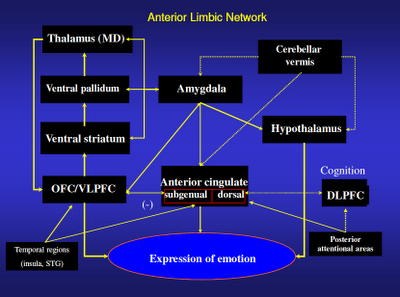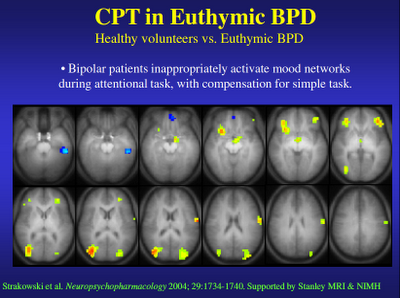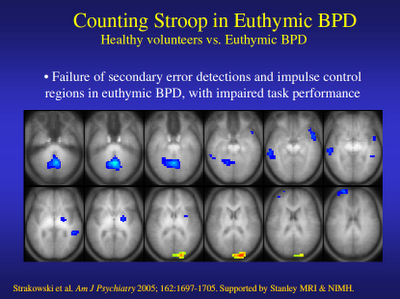
 THINKING AND STRESS
THINKING AND STRESS

Stressed brains have to work a lot harder in order to think.
by John McManamy
ONE of the major stories in bipolar over the past decade is the growing recognition that the condition is way more than a mood disorder. On one hand, we are talking about the thinking cortical regions that fail to boot up properly, even in euthymic (well) patients. On the other, we are talking about the reactive limbic regions that boot up all too well. Too frequently the neural networks that connect the two are severely compromised. Bad things happen.
At the 20011 9th International Bipolar Conference, Stephen Strakowski of the University of Cincinnati presented the equivalent of a master’s class.

Above is a representation of the anterior limbic network (ALN). Forget for the time being about specific brain regions and which region is responsible for what. Instead, check out the arrows in the picture that represent how these regions talk and cross-talk with one another. In a 2006 article on CNS Spectrums, Dr Strakowski refers to the old brain science as a “form of phrenology” that wrongly suggested that specific portions of the brain are associated with specific cognitive and emotional traits. Rather:
More recent neuroimaging studies suggest that emotion regulation is an emergent phenomenon that arises out of specific neural networks and that bipolar disorder represents the consequences of dysregulation in these networks.
Okay, let’s see how this works. In a 2004 brain scan study, euthymic bipolar patients performed as well on a simple cognitive task as the healthy controls, but to keep up the bipolars had to activate more brain regions. Dr Strakowski in his talk disclosed he had originally misinterpreted the results. What happened, he said, on later reflection was that the amygdala (which mediates arousal and fear) in the bipolar subjects lit up like a Christmas tree. To compensate for the over-active amygdala, the bipolars recruited the ventral medial prefrontal cortex (VMPFC). Image below.
SIGN UP FOR MY FREE EMAIL NEWSLETTER

So, even in routine situations, our brains are subject to stress. And to make up for it, we have to work the thinking parts of the brain harder. No harm, no foul, right?
In another experiment, Stakowski and his colleagues turned up the heat. This time, the subjects were put through a more complex cognitive task called the “counting Stroop,” which involves sorting out incongruent images in rapid succession (such as the number four spelled out three times). In this task, the bipolars scored rather worse than the healthy controls.
Here’s where it really gets interesting. As the task got more difficult, the controls were successful in easing back and slowing down their reaction times, allowing them precious micro-seconds to bring the cognitive areas of the brain online, in particular the regions involved in impulse-control. The bipolars, by contrast, failed miserably in this regard. They kept plowing ahead.

In another study, involving a facial recognition task, Strakowski and his colleagues found difficulties in bipolars in recruiting the VMPFC to suppress amygdala over-activity, resulting in loss of prefrontal control over the brain. In yet another study, the cingulate in the midbrain failed to sort out background noise. On and on it went.
So, imagine yourself in a crowded room this time, not in a brain scan machine. Even the routine task of talking to someone you feel comfortable with may be stressful. Then a stranger sidles over. Meanwhile, you are finding it difficult to tune out a million and one things going on in the room. Everything seems to be closing in. Then your mother-in-law barges in and starts yapping away.
Maybe you rise to the occasion and handle the situation superbly. But you know there is going to be hell to pay some time later. In all likelihood, you will arrive home, either feeling like a wrung-out dish rag or with racing thoughts - or maybe both - needing at least a precious day of recovery time you don’t have. Heaven forbid if you have an important meeting with your boss first thing in the morning.
Improving Brain Function
Two years before, at the International Congress on Schizophrenia, I happened to walk into a session entitled, "Optimizing Cognitive Training Approaches in Schizophrenia." From a blog piece, Figuring Out Schizophrenia, I did soon after ...
Translation: The brain is plastic. As Michael Merzenich of UCSF describes it, "Basically, we create ourselves."
The brain is born stupid, then evolves and becomes "massively optimized to fit into your world."
In recognition of this, a relatively new field is opening up that involves drilling patients in cognitive tasks we tend to take for granted, such as holding a thought in our working memory long enough to lay down new neural roadwork or responding to stimuli in a timely fashion.
New computer programs are being developed and being tested on patients, Sophia Vinogradov of UCSF explains, and we are seeing enduring changes in the cognitive performance of patients six months later.
(Note: Dr Merzenich has commercial interests in this.)
One more point: The studies Dr Strakowski and others perform are designed to catch us at our cognitive worst. These studies are comparatively easy to design and execute. Studies that would catch us at our best - formulating a creative response, thinking outside the box, reaching an intuitive insight - simply do not exist. We know our brains are precision-tooled for this, and researchers such as Nancy Andreasen of the University of Iowa are studying the phenomena very intently. But there is no way to capture the birth of a creative idea in a brain scan machine.
But at least a picture - good and bad - is beginning to emerge of what is going on beneath the hood. And in this type of self-knowledge lies the key to leading more fulfilling lives than we could have imagined when we were initially blindsided by this illness.
First published as a blog June 12, 2011, republished as an article Jan 16, 2012, revised Dec 5, 2016
NEW!
Follow me on the road. Check out my New Heart, New Start blog.












